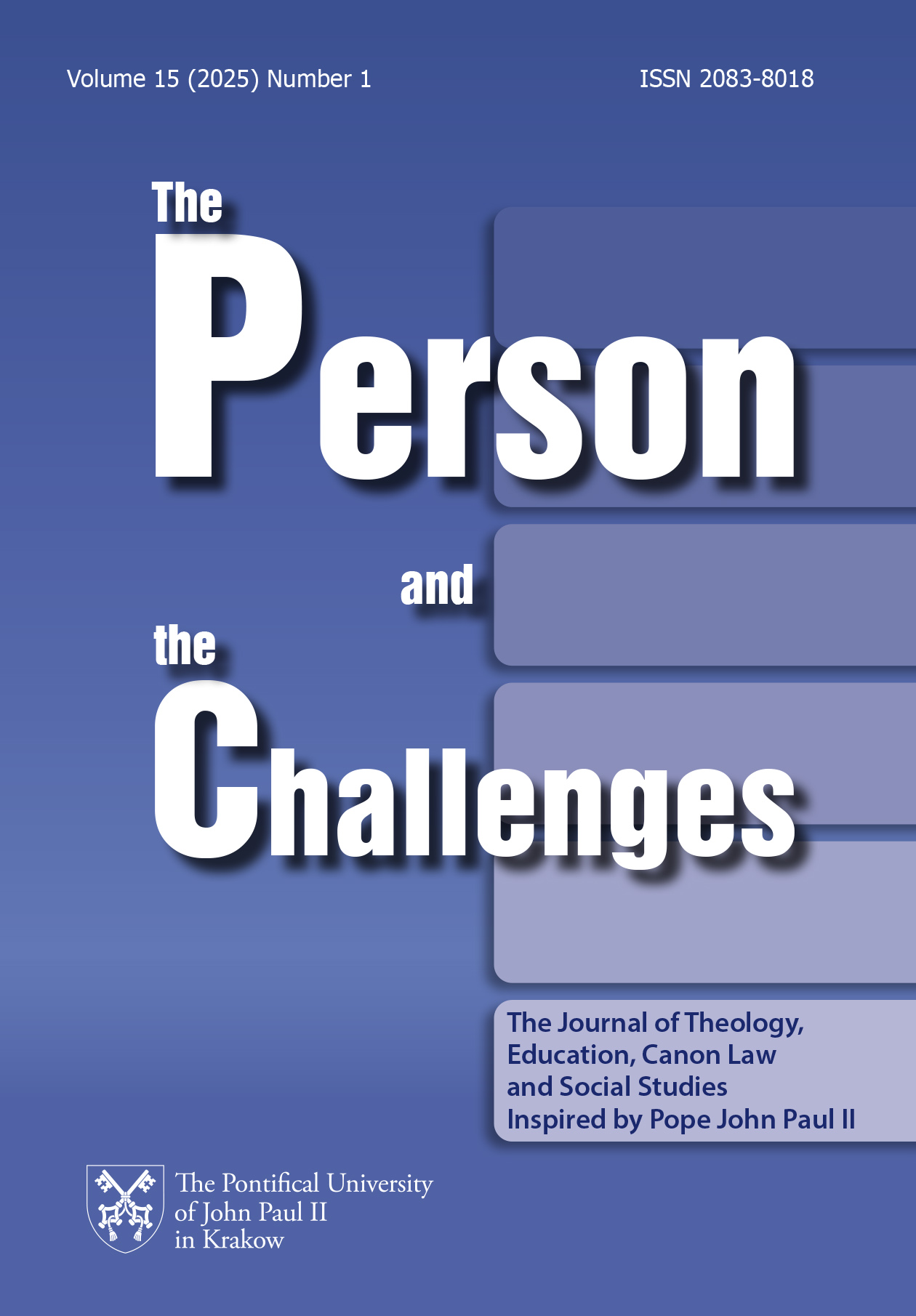Closeness in human relationships from an interdisciplinary perspective
DOI:
https://doi.org/10.15633/pch.15113Słowa kluczowe:
interpersonal closeness, interdisciplinary research, relationshipsAbstrakt
Interpersonal closeness is a research issue, the exploration of which requires an interdisciplinary approach. The realisation of this objective has resulted in the presentation of closeness from a proxemic, haptic, psychopedagogical, philosophical and theological perspective. The outcome of the exploration is showing the contexts for understanding and implementing closeness in different areas of life. The article presents an attempt to conceptualise interpersonal closeness, which draws on the author’s research. Its findings complement the literature search on the subject. Closeness is the co-presence of people and its purpose is mutual bestowing. The nature of this relationship is determined by internal factors as well as external conditions. What emerges from the analyses are postulates for establishing and strengthening closeness between people.
Bibliografia
Ainsworth M. D. S., Bell S. M., Attachment, exploration, and separation: Illustrated by the behavior of one-year-olds in a strange situation, “Child Development” 41 (1970) no. 1, pp. 49–67.
Aron A. P., Mashek D. J., Aron E. N., Closeness as including other in the self, in: D. J. Mashek, A. P. Aron (eds.), Handbook of closeness and intimacy, New York 2004, Lawrence Erlbaum Associates Publishers, pp. 27–41.
Aronson E., Aronson J., Człowiek – istota społeczna, Warszawa 2020, PWN.
Bembennek K., Problem rozpoznania (reconnaissance) Innego w kontekście Ricoeurowskiej dyskusji ze stanowiskami Husserla i Lévinasa, “Filo-Sofija” 18 (2018) 42, pp. 61–74.
Berscheid E., Snyder M., Omoto A. M., The relationship closeness inventory: Assessing the closeness of interpersonal relationships, “Journal of Personality and Social Psychology” 57 (1989) no. 5, pp. 792–807.
Borutka T., Caring for the person and the human family as a priority for the state and the church, “The Person and the Challenges” 10 (2020) no. 1, pp. 235–251.
Charmaz K., Constructionism and the grounded theory method, in: J. A. Holstein, J. F. Gubrium (eds.), Handbook of constructionist research, New York 2008, The Guilford Press, pp. 397–412.
Dola T., Czułość Boga, “ACADEMIA. Magazyn Polskiej Akademii Nauk” (2020) no. 1 (61), pp. 56–59.
Ekmekcioglu C., Dotknij mnie. Dlaczego dotyk jest tak ważny, Łódź 2019, Feeria.
Erikson E. H., Erikson J. M., Dopełniony cykl życia, Gliwice 2011, Helion.
Francis, Our God is close and asks us to be close to each other, 18 March 2020, https://www.vatican.va/content/francesco/en/cotidie/2020/documents/papa-francesco-cotidie_20200318_pergli-operatorisanitari.html (26.11.2023).
Godawa G., Znaczenie dotyku w edukacji. Model węgierski, in: A. Kamińska, P. Oleśniewicz (eds.), Edukacja jutra. Zróżnicowane obszary rozwoju edukacji instytucjonalnej, Sosnowiec 2020, Akademia Sztuki Wojennej, pp. 117–129.
Godawa G., Pedagogia bliskości międzyludzkiej, Kraków 2023, Impuls.
Guardini R., Bóg daleki, Bóg bliski, Poznań 1991, W Drodze.
Hess J. A., Fannin A. D., Pollom L. H., Creating closeness: Discerning and measuring strategies for fostering closer relationships, “Personal Relationships” 14 (2007) no. 1, pp. 25–44.
Holc P., Trójca Święta przyczyną sprawczą i wzorczą jedności Kościoła: eklezjologiczne pryncypium na kanwie teologicznego dialogu katolicko-luterańskiego, in: A. Baron, J. Kupczak, J. D. Szczurek (eds.), Rozwój dogmatu trynitarnego: perspektywa historiozbawcza, Kraków 2015, Uniwersytet Papieski Jana Pawła II w Krakowie Wydawnictwo Naukowe, pp. 235–268.
Jarząbek K., Słownik mowy ciała Polaków, Katowice 2016, Wydawnictwo Uniwersytetu Śląskiego.
Kerr S., Hudenko W. J., Godfrey D. A., Lundgren S. N., O’Malley A. J., Sharp C., Validation of the emotional tone index for families (ETIF): A multi-informant measure of emotional closeness, “Family Process” 60 (2021) no. 3, pp. 935–949.
Kurczewska J., Wariacje na temat interdyscyplinarności, in: S. Biliński (ed.), Oceny nauki, vol. 1, Kraków 2014, Polska Akademia Umiejętności, pp. 80–89.
Lévinas E., Inaczej niż być lub ponad istotą, Warszawa 2000, Aletheia.
Maliszewski K., Dotknięcie pedagogiczne – nauczyciel jako wydarzenie, in: J. Kurek, K. Maliszewski (eds.), W przestrzeni dotyku, Chorzów 2009, MDK “Batory”, pp. 211–218.
Osewska E., Rodzina i szkoła w Polsce wobec współczesnych wyzwań wychowawczych, Kraków 2020, Uniwersytet Papieski Jana Pawła II w Krakowie Wydawnictwo Naukowe.
Ricoeur P., Proces metaforyczny jako poznanie, wyobrażenie i odczuwanie, “Pamiętnik Literacki: czasopismo kwartalne poświęcone historii i krytyce literatury polskiej” 75 (1984) no. 2, pp. 269–286.
Ryś M., Greszta E., Grabarczyk K., Intelektualna, emocjonalna i działaniowa bliskość małżonków a ich gotowość do rozwiązywania konfliktów oraz przebaczania, “Fides et Ratio” 38 (2019) no. 2, pp. 221–254.
Sikorski W., Przestrzeń w kształtowaniu relacji międzyludzkich, Warszawa 2023, Difin.
izolacja, przywiązanie in: Sillamy N., Słownik psychologii, Warszawa 1994, Książnica.
Stala J., Personal and social trust in contemporary Poland in the light of empirical research, “The Person and the Challenges” 11 (2021) no. 2, pp. 47–61.
Sztejnberg A., Jasiński T., Proksemika w komunikacji społecznej, Płock 2007, Novum.
St. Thomas, Traktat o Bogu, Summa teologii 1, kwestie 1–26, Kraków 1999, Znak.
Tischner J., Filozofia dramatu, Kraków 2006, Znak.
Wojtyła K., Osoba i czyn, Kraków 1969, Polskie Towarzystwo Teologiczne.
Zborowski M., Teologia bliskości Boga – soteryjne implikacje bliskości Boga w Jezusie Chrystusie w komentarzach i homiliach do Ewangelii synoptycznych Orygenesa, “Teologia w Polsce” 9 (2015) no. 2, pp. 231–249.
Żywczok A., Hermeneutyka uczuciowej i duchowej bliskości, in: A. Żywczok (ed.), Miłość – akt preferencji duchowości człowieka. Studium bliskości duchowej, Warszawa 2013, Żak, pp. 21–35.
Pobrania
Opublikowane
Numer
Dział
Licencja
Prawa autorskie (c) 2025 Grzegorz Godawa

Utwór dostępny jest na licencji Creative Commons Uznanie autorstwa 4.0 Międzynarodowe.
Autorzy publikujący w czasopiśmie udzielają jego wydawcy zgody o następującej treści:
- Autor zachowuje autorskie prawa majątkowe do utworu, a jednocześnie udziela wydawcy czasopisma zgody na jego pierwszą publikację w wersji drukowanej i wersji online na licencji Creative Commons Uznanie autorstwa 4.0 Międzynarodowe oraz zgody na wykonywanie opracowań, w tym przekładów.
- Autor ma możliwość udzielania zgody niewyłącznej na opublikowanie utworu w wersji, która ukazała się w czasopiśmie (np. zamieszczenia go w repozytorium instytucjonalnym lub opublikowania w książce), wraz z informacją o jego pierwszej publikacji w czasopiśmie.
- Autor może umieścić swój utwór online (np. w repozytorium instytucjonalnym lub na swojej stronie internetowej) jeszcze przed zgłoszeniem utworu do czasopisma.

